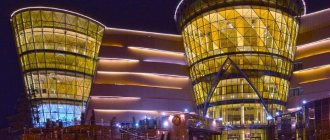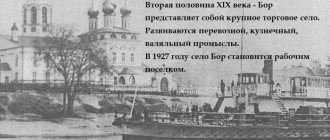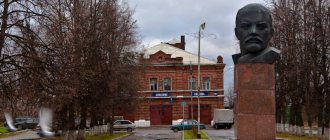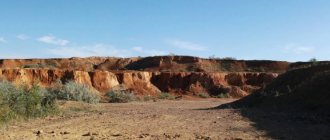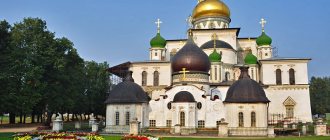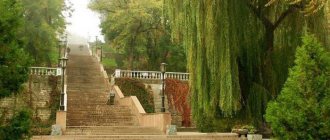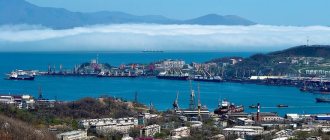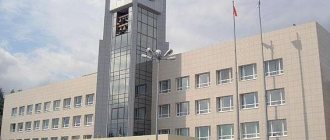Sights of the city of Obninsk.
What are the guidebooks silent about?!. Obninsk is the very first science city of the Russian Federation, this city is located in the territorial division of the Kaluga region and today we will talk about the sights of Obninsk. We have all heard the term “science city” many times, but not everyone has the concept. So, a science city is a city with a very high scientific and technical potential. The city-forming element of these cities is some kind of scientific and technical complex.
Sights of the city of nuclear scientists
Undoubtedly, the policy of conducting atomic research at that time left a certain imprint on the architecture of the city and the orientation of memorial sites. An example of this is the monument to submariners in the form of the wheelhouse of a real nuclear-powered submarine K-14, which has a legendary history. In the fall of 1966, the K-14 submarine with the call sign “Kit” spent two weeks searching for the Soviet drifting polar station “North Pole - 15”. This monument was erected for the contribution of Obninsk scientists. Despite the fact that Obninsk is located far from the sea, it was in this town that one of the first training centers for submariners was opened.
Where to go in Obninsk? Travelers will be interested to see the tallest meteorological mast not only in our country, but also in Europe. This 310-meter-high landmark is a destination for tour groups and individual travelers. True, you won’t be able to get inside the tower, but it’s easy to see the tallest weather tower and take a selfie against its background. It is especially interesting to watch it late in the evening or at night when the lights turn on.
Another attraction of the city is the first nuclear power plant, built in 1954, which operated trouble-free for the benefit of Russia for 48 years. In 2002, the nuclear power plant was decommissioned, and at this time it is another memorial monument. Read more about the attractions in the publication: https://fb.ru/article/251966/vyidayuschiesya-dostoprimechatelnosti-obninsk-i-ego-znamenityie-kulturnyie-obyektyi.
Our monuments are our heroes. City of Obninsk
Memory Alley
On October 5, 2012, on the territory of school No. 11 in Obninsk named after the Podolsk cadets, the grand opening of a memorial stone took place, erected in memory of the feat of the Podolsk cadets at the Ilyinsky lines, who exactly 71 years ago, by taking the fight, thwarted the German plan for the sudden capture of Moscow. On the stone is written: “MEMORY ALLEY” was planted in 1982 by veterans of Podolsk military schools - participants in the battles near Moscow in October 1941.” Next to the inscription is an image of the veteran Badge of a Podolsk cadet. In October 1941, Podolsk cadets, 3.5 thousand children aged 18-19, held the Warsaw Highway for more than a week, preventing the German tank corps (200 tanks, 20 thousand infantry, artillery, aviation) from breaking through to Moscow. Only one in ten survived.
Memorial complex "Eternal Flame"
In 1972, the Eternal Flame memorial complex was opened, built according to the design of the Leningrad architect L.S. Alexandrova. The remains of soldiers who died in battles and died from wounds in hospitals were transferred here, to a mass grave, from all mass and single graves located on the territory of Obninsk. The names of three hundred soldiers buried here are carved on the granite slabs of the memorial. Their names were restored from the lists of three military hospitals located here. In 1975, on the eve of the 30th anniversary of the Victory, capsules with the soil of the Hero Cities and the Brest Fortress were installed at the Eternal Flame memorial.
Monument to prisoners of fascist concentration camps
Thirty years after the opening of the Eternal Flame memorial complex, on October 25, 2002, its composition was supplemented by a monument to prisoners of fascist concentration camps. The authors are Kaluga sculptors V.I. Belov and D.V. Belov. This is a granite stele with a bas-relief, from where the piercingly living faces of tortured prisoners, children and adults look directly at us from the past.
Memorial stone-sign (Alley of Veterans)
In 1985, in honor of the 40th anniversary of the Victory, the Alley of Veterans was founded on Mira Street in Obninsk, as evidenced by a memorial stone sign (the Alley of Veterans was founded in honor of the 40th anniversary of the Victory).
Memorial stone in memory of police officers who participated in the Great Patriotic War
The memorial stone was installed in 2005 on Lenin Avenue (opposite the police school building, Lenin Avenue, 89).
Memorial stone of the Western Front Headquarters
The headquarters of the Western Front was stationed on the territory of Obninsk, which is now occupied by the Physics and Energy Institute (from May 23, 1942 to April 16, 1943). It was a large-scale military engineering complex, the only one of its kind - nothing like it was created during all the years of the war. The Headquarters territory was surrounded by a powerful all-round defense system. All buildings and structures were carefully disguised with camouflage. Subsequently, an underground command post was additionally built here, covered with six roll-ups of rails and steel sheets. It was connected by an underground passage to the Morozova mansion.
Memorial plaque on the Morozov Dacha building about the location of the command post of the commander of the Western Front
The leadership center of the headquarters - the command post - was located in the Morozov Dacha. Here, under the leadership of G.K. Zhukov developed the most important strategic operations that largely determined the further course of the war, including the Stalingrad operation.
Memorial plaque Street named after Marshal G.K. Zhukova
In Obninsk, in 1975, Druzhby Boulevard was renamed the street named after Marshal Zhukov, as evidenced by the memorial plaque on the wall of music school No. 1. Soviet military leader, Marshal of the Soviet Union, four times Hero of the Soviet Union - Georgy Konstantinovich Zhukov - was born on November 19 ( December 1) 1896 in the village of Strelkovka, Ugodsko-Zavodskaya volost, Maloyaroslavets district, Kaluga province (now Zhukovsky district, Kaluga region) in the family of peasants Konstantin Artemyevich and Ustinya Artemyevna Zhukov.
Memorial plaque to Nikolai Mikhailovich Balakirev
The words are carved on the memorial plaque: “In this house from 1976 – 2001. lived a participant in the Great Patriotic War, Hero of the Soviet Union, Nikolai Mikhailovich Balakirev.” House address: Obninsk, st. Zvezdnaya, 5.
Balakirev Nikolai Mikhailovich (1922 - 2001) - squadron commander of the 218th assault aviation regiment (299th assault aviation Nizhinsk Red Banner Division, 16th Air Army, Belorussian Front), senior lieutenant. Born on December 18, 1922 in the village of Reshetikha, Dzerzhinsky district, Gorky region (now an urban village of Volodarsky district, Nizhny Novgorod region), in a working-class family. At the age of 22, by Decree of the Presidium of the Supreme Soviet of the USSR dated July 1, 1944, he was awarded the Title of Hero of the Soviet Union for 189 combat missions on an IL-2 attack aircraft, causing great damage to the enemy and demonstrating courage and courage. Awarded the Order of Lenin (July 1, 1944), three Orders of the Red Banner, the Order of Alexander Nevsky, the Order of the Patriotic War, 1st degree, two Orders of the Red Star, the Order “For Service to the Motherland in the Armed Forces of the USSR”, 3rd degree, and medals. Died on May 29, 2001.
Memorial plaque to Mikhail Alekseevich Guryanov
The memorial plaque is mounted on the wall of house No. 1 on Guryanov Street in Obninsk. She talks about naming the street in 1965 after the Hero of the Soviet Union Mikhail Alekseevich Guryanov.
Guryanov Mikhail Alekseevich (1903-1941) was born on October 10, 1903 in the village of Novo-Petrovskoye, Istrinsky district, Moscow region. During the Great Patriotic War, he was a commissar of a partisan detachment operating in the Ugodsko-Zavodsky district. On the night of November 24, 1941, partisan groups, one of which was led by M.A. Guryanov, surrounded the building of the former district executive committee and destroyed the Nazis who were there. While retreating near the village of Ryzhkovo, Guryanov was ambushed, wounded and captured by punitive forces. On November 27, 1941 he was hanged by the Nazis. By a decree of the Presidium of the Supreme Soviet of the USSR dated February 16, 1942, for the exemplary performance of combat missions of the command on the front of the fight against the Nazi invaders and the courage and heroism displayed, the commissar of the partisan detachment, Mikhail Alekseevich Guryanov, was posthumously awarded the title of Hero of the Soviet Union. Mikhail Alekseevich Guryanov was buried in the city of Zhukov, Kaluga region.
Memorial plaque to Alexey Vladimirovich Kardashin
The words are carved on the memorial plaque: “In this house in 1965 - 1984. lived a participant in the Great Patriotic War, Hero of the Soviet Union, Aleksey Vladimirovich Kardashin.
Kardashin Alexey Vladimirovich (1921-1984) was born on February 21, 1921 in the village of Kardashi, Slobodsky district, Vyatka province, into a peasant family. In 1940 he was drafted into the Red Army and served in tank forces in the Far East. He took part in battles on the Volkhov, Central, 1st and 2nd Ukrainian, 1st Belorussian fronts. He was the commander of a tank company of the 48th Guards Tank Brigade of the 12th Guards Tank Corps of the 2nd Guards Tank Army of the 1st Belorussian Front, a guard senior lieutenant. He particularly distinguished himself in battles on German territory, during the crossing of the Oder River in April 1945.
By a decree of the Presidium of the Supreme Soviet of the USSR dated May 31, 1945, for the exemplary fulfillment of command assignments and the courage and heroism shown in battles with the Nazi invaders of the guard, senior lieutenant Alexei Vladimirovich Kardashin was awarded the title of Hero of the Soviet Union with the presentation of the Order of Lenin and the Gold Star medal ( No. 6755).
In 1959, he retired to the reserve with the rank of lieutenant colonel and lived in Obninsk. He died in 1984 and was buried at the Konchalovskoye cemetery.
Memorial plaque to Fedor Antonovich Legkoshkur
The words are carved on the memorial plaque: “From 1968 to 1996, in this house, from 1968 to 1996, lived the right flank of the Victory Parade on Red Square in Moscow in 1945, a participant in the Great Patriotic War, Fedor Antonovich Legkoshkur (04/02/1919 – 07/21/1996).” The memorial plaque was installed on June 24, 2013 on the wall of a residential building on the street. Komarova 9. Fedor Antonovich Legkoshkur (1919-1996) was born on April 2, 1919 in the village of Khoroshoe, Petropavlovsk district, Dnepropetrovsk region. He was drafted into the army in 1939. He fought in the Caucasus and Kuban in a division under the command of Colonel M.E. Mikryukov, was wounded twice and shell-shocked. He took part in the historical Victory Parade in Moscow on Red Square on June 24, 1945, to commemorate the USSR's victory over Germany in the Great Patriotic War. The march of the combined regiments was completed by a column of soldiers carrying 200 lowered banners and standards of the defeated German troops. These banners, accompanied by the beat of drums, were thrown onto a special platform at the foot of the Lenin Mausoleum. Fyodor Legkoshkur threw down the first standard - the Leibstandarte LSSAH of the SS battalion of Hitler's personal guard. Legkoshkur F.A. died. - July 21, 1996, buried at the Konchalovskoye cemetery.
Memorial plaque to Vasily Vasilievich Migunov
The memorial plaque is mounted on the wall of the house located at the address: Obninsk, Lenin Ave., 11/6.
Memorial plaque to Vasily Vasilievich Migunov
On the memorial plaque are the words: “At the school named after. S.T. Shatsky in 1930 – 1934. studied Migunov Vasily Vasilievich pilot Hero of the Soviet Union died in battles for the Motherland on March 31, 1942.” A memorial plaque is installed near the main entrance to school No. 1 named after. S.T. Shatsky.
Migunov Vasily Vasilyevich (1918 - 1942) was born in 1918 in the village of Krivskoye, Borovsky district, Kaluga province. In the Red Army since 1938. Participant of the Great Patriotic War since June 1941. He was a pilot of the 29th Fighter Aviation Regiment of the 31st Mixed Aviation Division of the Air Force of the 61st Army of the Western Front. By October 1941, he had flown 170 combat missions, including 66 aerial reconnaissance missions. In air battles he shot down 5 enemy aircraft. On October 22, 1941, by Decree of the Presidium of the Supreme Soviet of the USSR, Lieutenant Migunov was awarded the title of Hero of the Soviet Union with the Order of Lenin and the Gold Star medal (No. 628). He died on March 31, 1942 in an air battle near the village of Budovo, Kalinin Region, when he was rammed by an enemy fighter. He was buried in mass grave No. 5 of the civil cemetery of Ivan the Bogoslov on the western outskirts of Torzhok.
Bust of Hero of the Soviet Union Leonid Gavrilovich Osipenko
The bust was installed in the park at the intersection of Pobeda and Kurchatov streets. The same bust was installed in the courtyard of school No. 4, which bears the name of L.G. Osipenko. The words are carved on the bust: “Hero of the Soviet Union, Rear Admiral Leonid Gavrilovich Osipenko, commander of the first nuclear submarine, honorary citizen of the city of Obninsk.”
Leonid Gavrilovich Osipenko (1920-1997) – commander of the first Soviet nuclear submarine K-3 “Leninsky Komsomol”, participant in the Great Patriotic War, Hero of the Soviet Union. Born on May 11, 1920 in the village of Krindichevka, Lugansk region, into a working-class family. In December 1941, he was sent as a backup commander of the BC-3 to the submarine Shch-201 and took part in the Kerch-Feodosia landing operation. In August 1955, Osipenko was appointed commander of the first Soviet nuclear submarine (NPS) of Project 627 “Kit”. On March 12, 1959, she was assigned the tactical number K-3 “Leninsky Komsomol”. July 23, 1959 for the successful completion of the government task of commissioning the first submarine with a nuclear power plant into the USSR Navy and, at the same time, courage and courage to captain 1st rank Osipenko L.G. was awarded the title of Hero of the Soviet Union with the Order of Lenin and the Gold Star medal. In 1980 he retired with the rank of rear admiral. Died on March 14, 1997. He was buried at the Konchalovskoye cemetery in Obninsk.
Memorial plaque to Ilya Fedorovich Trushkov
The memorial plaque is mounted on the wall of the house in which I.F. Trushkov lived. (Aksenova st., 7). The words are carved on the memorial plaque: “In this house in 1977-1993. lived a participant in the Great Patriotic War, Hero of the Soviet Union, Ilya Fedorovich Trushkov.”
Ilya Fedorovich Trushkov (1925-1993) - was born on July 25, 1925 in the village of Novotroitskoye, Sterlitamak region, Bashkiria, into a peasant family. He was drafted into the Red Army in February 1943. In June 1944, 19-year-old young officer Trushkov I.F. ended up in the active army, fought on the 3rd Ukrainian and 1st Belorussian fronts. As the commander of a machine gun platoon of the 19th Mechanized Brigade (1st Mechanized Corps, 2nd Guards Tank Army, 1st Belorussian Front), he distinguished himself in battles on the outskirts of the capital of Nazi Germany - the city of Berlin. By decree of the Presidium of the Supreme Soviet of the USSR dated May 31, 1945, for skillful command of the battery, exemplary performance of combat missions of the command and demonstrated courage and heroism in battles with the Nazi invaders, senior lieutenant Ilya Fedorovich Trushkov was awarded the title of Hero of the Soviet Union with the Order of Lenin and the Gold medal Star". He was also awarded the Orders of Lenin, the Red Banner, the First Class of the Patriotic War, the Red Star, etc. Since 1976, reserve colonel I.F. Trushkov lived and worked in Obninsk. Died on January 4, 1993. He was buried in Obninsk - at the Konchalovskoye cemetery. Literature: Memory Alley 1. Fokin, P. Those who saved Moscow [Text] / P. Fokin // Events: weekly information newspaper. - 2012. - No. 33. - P. 6. 2. Administration of the city of Obninsk [Electronic resource]: photographs. – Obninsk, 2014. – Access mode: http: /www.admobninsk.ru/news/news_1684.html. — 2014. Memorial complex “Eternal Flame” / Monument to prisoners of fascist concentration camps / Memorial stone-sign (Alley of Veterans) / Memorial stone in memory of police officers - participants in the Great Patriotic War 3. Obninsk - the first science city of Russia: history and modernity [Text] = Obninsk- the first scientific city of Russia: past and present / ed. T.M. Larina. - Obninsk: Resource, 2006. - 432 p. 4. Sukhov, L.N. Names of heroes in the toponymy of Obninsk / L.N. Sukhov // Priobninsky region. City and surroundings. History and modernity [Text]: works of the Obninsk local history association “Repinka”: vol. 1: vol.1 / ed. V.A. Tarasov. – Obninsk: Rosintal, 2012. – 174 p. Memorial stone of the Western Front Headquarters / Memorial plaque on the Morozov Dacha building about the location of the command post of the commander of the Western Front 5. Obninsk - the first science city of Russia: history and modernity [Text] = Obninsk- the first science city of Russia: past and present / edit . T.M. Larina. - Obninsk: Resource, 2006. - P. 169 - 173. Memorial plaque Street named after Marshal G.K. Zhukova 6. Obninsk: History of the city and region from ancient times to the present day [Text] / T. M. Larina, A. P. Sorokin, V. T. Tarasov and others; edited by T. M. Larina. — 2nd ed., rev. and additional – Obninsk: Resource, 2004. – 328 p. 7. Sobachkin, A. Zhukov in Obninsk [Text] // NG-region. - 2012. - No. 17. - P. 4. 8. Fokin, P. Zhukov Street [Text] // Events. - 2013. - No. 5.- P.6. 9. Zhukov Georgy Konstantinovich [Electronic resource]. – Access mode: www. URL: https://ru.wikipedia.org/wiki/Zhukov,_Georgy_Konstantinovich. — 03/21/2013. 10. Zhukov Georgy Konstantinovich [Electronic resource]. – Access mode: www. URL: https://www.biograph-soldat.ru/MARSHALS/ARTICLES/003-zhukov.htm.- 03/21/2013. Memorial plaque to Balakirev Nikolai Mikhailovich 11. Book of memory of those who fell during the Great Patriotic War. 1941-1945. Kaluga region [Text]: historical literature: vol. 6 (additional) / general. ed. T.V. Romanova; thin D.Ya. Moiseev. — Kaluga: [b. i.], 2000. – P.492. 12. V. P. Rossovsky “Golden Stars of Orenburg” [Text]: biographical reference book. - Chelyabinsk: South Ural Book Publishing House, 1989. - P. 48 - 49. 13. People of Obninsk: Nikolai Mikhailovich Balakirev [Electronic resource]. — Access mode: www.URL: https://iobninsk.ru/nikolay-mikhailovich-balakirev/. — 04/12/2013. 14. Heroes of the country [Electronic resource]. — Access mode: www.URL: https://www.warheroes.ru/hero/hero.asp?Hero_id=13597. — 04/12/2013. 15. Photos of the portal “AYK-Obninsk” are used in the text. Memorial plaque to Mikhail Alekseevich Guryanov 16. Fokin, P. Guryanova Street [Text] // Events. - 2013. - No. 1. - P. 5. 17. Guryanov Mikhail Alekseevich [Electronic resource]. – Access mode: www.URL: https://ru.wikipedia.org/wiki/Guryanov,_Mikhail_Alekseevich. — 03/21/2013. 18. Guryanov Mikhail Alekseevich [Electronic resource]. – Access mode: www.URL:https://www.warheroes.ru/hero/hero.asp?Hero_id=7680. — 03/21/2013. Memorial plaque to Alexey Vladimirovich Kardashin 19. Kaluga Encyclopedia [Text] / ed. V.Ya. Filimonov. — 2nd ed., revised. and additional - Kaluga: Publishing House N. Bochkareva, 2005. - P. 261. 20. Book of memory of those who fell during the Great Patriotic War. 1941 – 1945. Kaluga region [Text]: historical literature: vol. 6 (additional) / general. ed. T.V. Romanova; thin D.Ya. Moiseev. — Kaluga: [b. i.], 2000. – P.502. 21. Sobachkin, A. Heroes [Text] / A. Sobachkin // People's newspaper "Region". - 2010. - N 17. - P. 2 - 3. Memorial plaque to Fedor Antonovich Legkoshkur 22. Opening of a memorial plaque in honor of the right-flank Victory Parade Fedor Legkoshkur [Electronic resource]. — Access mode: www.URL: https://www.admobninsk.ru/news/2013/06/21/news_2493.html. — 06/21/2013. Memorial plaque to Migunov Vasily Vasilievich / Memorial plaque to Migunov Vasily Vasilievich 23. Migunov Vasily Vasilievich [Electronic resource]. – Access mode: www.URL: https://ru.wikipedia.org/wiki/Migunov,_Vasily_Vasilievich. — 03/20/2013. Bust of Hero of the Soviet Union Osipenko Leonid Gavrilovich 24. Obninsk. History of the city and region from ancient times to the present day [Text]: collection / T.M. Larina, A.P. Sorokin, V.A. Tarasov; ed.-comp. T.M. Larina. — 2nd ed., rev. and additional - Obninsk: Resource, 2004. - 328 p. 25. Fomenko, P. Osipenko Street [Text] // Events. - 2012. - No. 33. - P. 5. 26. Osipenko Leonid Gavrilovich [Electronic resource]. – Access mode: www.URL: https://ru.wikipedia.org/wiki/Osipenko,_Leonid_Gavrilovich. — 03/21/2013. 27. Osipenko Leonid Gavrilovich. Heroes of the country [Electronic resource]. – Access mode: www.URL:https://www.warheroes.ru/hero/hero.asp?Hero_id=2363..- 03.22.2013. Memorial plaque to Ilya Fedorovich Trushkov 28. Kaluga Encyclopedia [Text] / ed. V.Ya. Filimonov. - Kaluga: N. Bochkareva Publishing House, 2000. - P. 594.-.595. 29. Sobachkin, L Heroes [Text] / A. Sobachkin // People's newspaper "Region". - 2010. - No. 17. - P. 2 - 3. 30. Ilya Fedorovich Trushkov [Text]. – Access mode: https://iobninsk.ru/ilya-fyodorovich-trushkov/. – 2014.
To the list of districts and cities of the Kaluga region
Monuments of Obninsk
A city landmark of Obninsk is a monument to the Russian nuclear physicist, founder of the atomic project I.V. Kurchatov, whom Obninsk residents reverence as the father of the city. The monument is located on the street of the same name, surrounded by a small birch grove.
Residents of the city are proud of another monument erected in mid-2021 in the center of Obninsk to the conquerors of the atom. In world history, this is the first monument honoring people of this profession. Ingenious simplicity and originality attract the attention of tourists both older and children. The unusual nature of the monument will remain in the memory of those who visited it for a long time. This is exactly the place where parents should go with their child in Obninsk.
How to get there
You can easily get to Obninsk from almost any big Russian city, because it is located only 1 hour drive from the Moscow ring highway.
By plane
At a distance of about 100 km from Obninsk there are 3 Moscow airports, from which you can get to your destination in 1.5-2 hours. The plane is considered the most optimal way to get to the city from remote regions.
From any airport in the capital, people first travel by metro (Kievskaya station) to the station, and from there to the populated area they need to go by train, the average cost of which is 240-280 rubles.
By train
Obninsk has a railway station, the station has the same name. This route connects Moscow and Bryansk. When purchasing a ticket to a desired stop, you should keep it until the end of the trip.
So, you can get to Bryansk by train in 4.5 hours. The cost of such a trip will cost at least 1000 rubles. The train will take passengers from Obninsk to the regional center in 1 hour. The ticket price will be about 380 rubles.
By bus
From the Russian capital, buses heading to Obninsk leave from the bus station located near the station. m. "Teply Stan". When purchasing a travel pass, you must present your passport, because personalized receipts are issued. Traffic flows along the Warsaw Highway. The trip takes about 1.5 hours. Ticket prices start from 215 rubles.
From the Obninsk station there are regular flights to the following settlements:
| Name of the locality | price, rub. | Travel time, min. |
| Zhukov | 25 | 20 |
| Serpukhov | 210 | 90 |
| Bryansk | 360 | 4-5 hours |
| Roslavl | 870 | 18:00 |
| Korsakovo | 180 | 70 |
| Novozybkov | 1420 | 14 hours 50 minutes |
| Dyatkovo | 685 | 4 hours 20 minutes |
| Kaluga | 100 | 90 |
By car
Obninsk on the map of Russia is located in the intersection zone of federal highways. There are several variations to get to the science city by car. In the urban area, 2 large highways intersect (M3 and A101). Both lead from Moscow.
One of them heads through Yaroslavl to Brest, and the other leads to Kyiv. Also nearby (approximately 5 km) is the A108 or Big Ring road.
Historical monuments
Where else can you go in Obninsk? Not only professional attractions are worthy of tourists' attention. This raises the question of where to go. Obninsk invites architecture lovers to explore the estate of the artist P. Konchalovsky “Bugry”, which is more than 130 years old. A one-story log house with a mezzanine, interesting from the point of view of house-building stylistics, is located on the outskirts of Obninsk. The estate has been preserved almost in its original form to this day. To preserve the architecture of the house, today's owners are carrying out its restoration.
Another architectural landmark of Obninsk is the Morozov Dacha - a stone structure dating back to the early twentieth millennium. Despite the fact that now the dacha is not in the beautiful condition of the Tsarist era, its external and internal walls have preserved features of luxury and the remains of beautiful architectural compositions, stucco moldings and frescoes.
Museum
For those who are more interested in the modern development of Obninsk, it is better to visit the Museum of the History of Obninsk with a large exhibition hall and an art salon. Its composition contains photographs and documents about the consistent development of the city, the construction of the country's first nuclear power plant and the highest meteorological tower in Europe, its other attractions and people who left their mark not only on Obninsk land, but those whom all of Russia knows. The guides will be happy to guide city guests through the museum’s exhibition and answer questions that interest tourists. In addition to the permanent composition, the museum periodically hosts thematic exhibitions, also related to the history of the city.
Temples and churches
Where should Christian believers go in Obninsk? In one of the villages of Obninsk - Ermolino - on the high bank of the Protva River there is a beautiful Church of St. Nicholas. The church was built as a wooden one in the 17th century, then it burned down and on this site was again rebuilt from stone at the end of the 19th century. The church is lovingly guarded by parishioners, the area is being improved, and a new fence is being built. There is always a piece of the relics of Matrona of Moscow in the church; in the church shop you can buy icons, candles, and submit notes with the names of Christians for whom they will pray during the service. Several holy springs are places of pilgrimage. It is especially crowded here during Christian holidays. The prayerful atmosphere of this place calms the soul and makes you look at everyday problems with completely different eyes.
One of the more modern temples is located in the city center. This is a spacious, beautiful Church of the Nativity of Christ, built at the beginning of the 21st century with money from the diocese, parishioners and patrons. Golden domes decorate the dome of the church; church bells ring out every day in the surrounding area of the city, notifying parishioners of the beginning and end of the service. At the church, in the parish school, Obninsk children learn Christian fundamentals.
Main attractions
Obninsk appeared on the map of Russia relatively recently, however, it has about 100 attractions. Among them, both natural and man-made interesting places stand out.
Weather tower
One of the highest meteorological towers in Europe was built in Obninsk, its length is 310 m. The meteorological tower called VMM-310 “Typhoon” was put into use in 1959. The structure is based on a spherical device; an elevator functions inside the mast for the movement of experts.
The design is made to measure many different atmospheric parameters, followed by their computer systematization. The information obtained using the weather tower is used to solve applied and scientific problems. The tower stands at the intersection of the street. Guryanov and Komarov.
Estate "Bugry"
The Bugry estate began its existence at the end of the 19th century. The estate belonged to A. Obninskaya, who inherited it from her parents. To this day, what has survived from the complex is a single-tier log dwelling with a mezzanine. Behind him stretched a large garden, and in front of the front of the house there was a picturesque park with exotic vegetation.
In 1932, the estate was sold to the painter P. Konchalovsky, and in it he created almost all of his Central Russian panoramas. Estate address: st. Dacha (after passing the church, you need to turn onto a country road that goes uphill). You can get here by public transport to the stop. "Konchalov Mountains".
Morozovskaya dacha
The Morozov dacha was built in the New England style at the turn of the 19th-20th centuries. designed by architect V. Lopatin. The owner of the estate was V. Obninsky, but since 1909 the estate was owned by M. Morozova. The new owner gave permission to establish a colony school on these lands for Moscow children from working families who lived in poor conditions. During the Second World War, the Red Army headquarters was based here.
After the war, a major renovation was carried out at the dacha, and then a hotel was opened in it. Now the mansion is under state protection, but, nevertheless, its condition is falling into disrepair. The estate rises on the top of a hill in a pine forest at the junction of the river. Repinka and Protva and has the address st. Pirogova, 1. You can walk here in a few minutes from the IPPE.
Museum of Obninsk History
The Obninsk Historical Museum opened its doors to visitors in May 1965. 27 years later, the institution moved to a specially constructed new premises, which resulted in an increase in staff and the creation of additional exhibitions. An exhibition and art salon was also founded. The museum collection numbers about 50 thousand items.
It tells about the historical events of the region and the emergence of the city. The Obninsk Museum includes two areas - local history and art. The institution is located at Lenin Ave., 128 and is open on Thursdays from 13.00 to 21.00, closed on Mondays, and on all other days the exhibition is open from 10.00 to 18.00.
The price of an entrance ticket for adults is 40-60 rubles, and preferential categories will have to pay 20-30 rubles. Entry cost for foreigners is 80-120 rubles. It is better to go here from the railway station by minibus No. 9,2,15 and 12 to the stop. "House of Scientists"
Guryanovsky forest
The Guryanovsky Forest is a large-scale forest zone in the central part of the city. After the collapse of the USSR, it fell into disrepair. At the present time, most of the forest space has become its own territory and is registered in the cadastral register. Here the space is being improved, pedestrian paths are laid and playgrounds are installed.
Belkinsky Park
The Belkinskaya park area extends on the northwestern outskirts of Obninsk in the village of the same name. The green space is clean and can be visited 24 hours a day.
There are a large number of picturesque places here - a gazebo, ponds, centuries-old trees, decorative bridges, the remains of an estate and the active church of St. Boris and Gleb.
The highlight of the park is the cascade of ponds. It is better to go here by public transport to the stop. "Belkino".
Suspension bridge over the river. Repinka
The suspension bridge began its existence in 1961 and it was laid across the ravine in which the river flows. Repinka. Initially, the cables replaced the cables used on the city's television mast. At the beginning of the XXI century. the pontoon fell into disrepair and for 10 years residents crossed the ravine below along the path.
In 2015, a new bridge was built at the same place, which is supported on metal piles. The structure connects the Old part of the city with the village. Peaceful. The suspended track is located near school No. 1 on the street. Pirogova, 17.
Eternal flame
The eternal flame was built on the mass grave moved from Lenin Avenue in 1972. The memorial complex was built according to the design of L. Alexandrov at the intersection of st. Zhukov and Mira. The monument is dedicated to the heroes of the Second World War who were buried on Obninsk land. About 300 names of warriors are engraved on granite plates, and hero cities are also indicated. Here is the final station of bus routes No. 1, 2 and 103.
Sculpture “Scientist Cat”
The figure of the “Scientist Cat” appeared in the city in 2013 due to the fact that a hundred-year-old oak tree remained nearby, and everyone knows the lines from Pushkin’s poem “Ruslan and Lyudmila.” The sculpture was installed near the facade of the House of Scientists at Lenin Ave., 129. You should go to this place by bus to the stop. "House of Communications"
Church of Boris and Gleb
Near the dilapidated Belkino estate stands the Church of Boris and Gleb, erected in 1776. The sanctuary was part of a manor complex built according to the design of V. Blank. The architectural traditions of Catherine’s times are noticeable in the outlines of the building. It also successfully combines classicism and baroque motifs. The inside of the church is painted using the grisaille technique.
During Soviet times, the temple was closed and a warehouse was built in it. After a long lull, the first service was held here in July 1988. Now the temple complex hosts a year-round cycle of services, and also operates an Orthodox school and library. Sanctuary opening hours: Wed and Fri from 18.00 to 19.00, Sat and Sun from 8.30 to 19.00.
Monument to Academician Kurchatov
The bronze monument to I. Kurchatov depicts the famous physicist, head of the Nuclear Power Plant project. The monument was made according to the design of O. Komov and looks like a slightly enlarged figure of an academician who sits in a chair on a low pedestal.
Nearby lies a birch grove, which has become an integral element of the composition. The sculpture was installed on the street of the same name, 21, in the park near the Central Park.
Monument to the Pioneers of Nuclear Energy
The first monument on the planet dedicated to the pioneers of nuclear energy was erected in the Russian science city of Obninsk in 2021. The monument is a silver sphere, in front of which stands a man with his hand outstretched high.
All nuclear settlements of the state are marked on the back of the ball. The composition is located on Triangular Square. The nearest public transport stations are Magazin Malysh and St. Department store".
MiG-21 aircraft
The monument was erected in 2021, and its main exhibit, a real MiG-21, was made more than half a century ago, and was opened in honor of the 60th anniversary of the science city. The plane actually flew for quite a long period. This vehicle is a supersonic light fighter.
The combat vehicle is parked on Gagarin Ave., at the main entrance of the Tekhnologiya plant. The nearest bus stop is called “Gas Station”, from it you need to walk 700 m.
Big fountain
A large fountain delights residents and guests of the city at the intersection of the street. Zhukov and Pobeda. The reservoir was in a neglected state for a long time, and only in 2014 restoration work began here.
After reconstruction, water jets rise above the bowl to the accompaniment of music.
The area adjacent to the building was landscaped - tiles were laid, benches were installed, bicycle parking was installed and lighting was installed. Bushes and trees are planted around the fountain.
Eiffel Tower
Although Obninsk is located on the map of Russia and not in France, it has the Eiffel Tower. In reality, the structure is a scaled-down model of the iconic landmark.
Obninsk has its own mini Eiffel Tower.
The figurative tower was installed in 2014, and is used mainly as a subject for photographs. At night, the tower is illuminated. The structure stands on the street. Kurchatova, 41, near the Akond office complex.
Church of the Nativity
The Church of the Nativity of Christ stands on Aksenovskaya Square and has the address: st. Engelsa, 12. This is a fairly young temple, built at the beginning of the 21st century. The sanctuary has beautiful decorations and gilded domes. There is a Sunday school on the temple grounds. The holy place can be visited daily from 9.00 to 19.00, and on Sunday the church is open from 6.30 to 19.00.
Old water tower
At the intersection of the street. Blokhintsev, etc. Lenin, the water tower erected by captured Germans in the middle of the 20th century has been preserved. The building was built in the Stalinist Empire style.
The design was intended to supply water to the settlement of object “B”, which was transformed into a city, and the relevance of the design was lost. Now the tower is part of private property, but it is not used in any way. The object acts as an element of the architectural ensemble and as a technical monument of the last century.
City Palace of Culture
Obninsk Palace of Culture is a cultural and educational municipal institution whose main task is the spiritual development of the population. Large-scale events are held here at both the city and all-Russian levels.
One of the main purposes of the complex is to develop amateur creativity in children and young people. The palace is located at: Lenin Ave., 126 and is open daily from 9.00 to 18.00. To get there you need to take a minibus to the stop. "House of Communications"
House of Scientists
In Obninsk in 1979, the House of Political Education was founded, which was eventually transformed into the House of Scientists. The institution hosts various educational, social and sporting events. There is a concert hall with a capacity of 615 seats and a lecture room with a capacity of 220 people. Large-scale conferences and forums are held in the main hall of the building.
The building was built according to the design of St. Petersburg architects, and Obninsk craftsmen designed the interior. The House of Scientists is located at Lenin Ave., 129. From Mon to Fri, the organization’s doors are open to visitors from 10.00 to 19.00, and on Sat and Sun its operating hours are from 10.00 to 18.00.
House of Culture of the Physics and Energy Institute
The IPPE House of Culture was put into operation in 1954. A number of circles functioned here, which later grew into large groups: a folk theater, 2 orchestras and a dance group. The cultural center was included in the list of historical and cultural city sites in 1991.
The Palace of Culture is part of the compositional ensemble of the Old Town and is located at 15 Lenin Ave. The organization is open daily from 8.00 to 22.00.
Cinema "Mir"
The cinema is located on the street. Shatsky, 20 and has been a favorite vacation spot for city residents for many years. Not so long ago, it underwent a major renovation, and now there are Large and Small cinema halls with a total number of seats designed for 390 people. Ultra-modern equipment is used to display films in three-dimensional image formats.
The repertoire includes both domestic and foreign films. The cinema building hosts various shows and events. The cinema is open to visitors every day from 10.00 to 23.00. The price of entrance tickets varies between 170-300 rubles.
4-hall cinema CINEMA De Lux
The modern multiplex CINEMA De Lux has 4 halls with 480 seats, and is also equipped with the latest rear projector and sound system. The complex also includes a minibar and a games area. Cinema location: Marx Ave., 45 (on the 3rd floor of the Triumph Plaza shopping and entertainment complex).
On weekdays, the cinema holds screenings from 12:00 to 00:00, and on Saturdays and Sundays they show 1 hour earlier. Tickets are in the price range of 150-350 rubles. There are many bus routes near the complex.
Cinema in the Leisure Center
The Obninsk “Leisure Center” is a cozy area that is popular with the local population. Here they show new releases from around the world and animated films for children. The cinema room has comfortable chairs.
The building was built on the street. Engelsa, 2-a and you can get to it by minibus to the station named after the street. At the cinema, screenings begin in the morning, and the last show starts at 20.15. The cost of entrance tickets varies in the price range from 150 to 300 rubles.
Chamber hall of the central library system
The centralized network of Obninsk libraries consists of 10 public library institutions. This system has at its disposal a chamber hall with 50 seats, located on the street. Engelsa, 14. Various concerts are regularly held there. It is better to get to the place by bus to the stop. "Music school" or "st. Engels".


